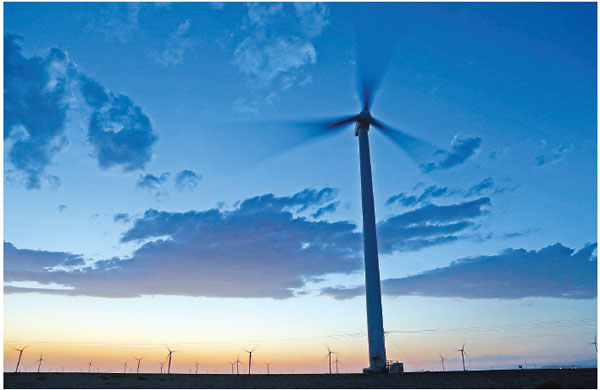Wind, solar resources-rich Xinjiang helps China's carbon neutrality efforts
Northwest China's Xinjiang Uygur Autonomous Region, a region rich in solar and wind resources, has made a great deal of headway in helping the country reach its dual targets of carbon neutrality and emission peak.

A wind turbine system generates energy in the Xinjiang Uygur Autonomous Region. (Photo/Xinhua)
According to the latest data from Xinjiang's development and reform commission, the installed capacity of wind and photovoltaic energy production in Xinjiang reached 23.552 million kilowatts and 12.06 million kilowatts respectively by the end of April.
Today, the volume of electricity generated by new energy in Xinjiang ranked first among all regions last year, a person with the State Grid Xinjiang Electric Power Co., Ltd. revealed, adding that not only did the volume of electricity generation from new energy in Xinjiang reach an all-time high, but its utilization efficiency has also gradually improved.
The utilization rate of new energy in Xinjiang was 63 percent in 2016. The figure gradually rose in the following years, reaching 91 percent last year.
The efficiency of new energy use in Xinjiang has had its best performance in history since the beginning of this year. Data from the development and reform commission in Xinjiang indicated that from January to April this year, the utilization rate of wind and photovoltaic power in Xinjiang reached 93.2 percent and 98.8 percent respectively, an increase of 4.5 and 4 percentage points respectively.
In terms of power generation, in the first four months of this year, the generation of wind and solar power increased significantly to 22.43 billion kilowatt-hours of electricity.
Furthermore, Xinjiang has also enjoyed economic benefits as a result of its new energy generation. Data from the State Grid Xinjiang Electric Power Co., Ltd. showed that the region has secured agreements on the outward transmission of its electric power with 20 provinces or cities across the country.
In 2020, the volume of electricity generated from new energy sent from Xinjiang to other regions exceeded 27 billion kilowatt-hours, equivalent to reducing the burning of standard coal by 8.25 million tons and reducing carbon dioxide, sulfur dioxide and nitrogen oxide by 23.32 million tons, 7 tons and 6.1 tons respectively.
Photos
Related Stories
- Zenz's Xinjiang population 'research' lacks evidence, ignores basic demographic facts: experts
- So-called "Uyghur Tribunal" an anti-China farce: FM spokesperson
- Anne in Xinjiang: Immersed in a shopping paradise at the Grand Bazaar
- In pics: Narat band in China's Xinjiang
- People in Xinjiang IV
- Xinjiang's Alashankou port sees roaring cross-border e-commerce business
- First desert expressway in Xinjiang expected to complete this year
- "Uyghur Tribunal" neither legal nor credible: Chinese embassy in UK
- Xinjiang sees record new energy power generation efficiency
- Ethnic Kazakh herdsmen move livestock to summer pastures in China's Xinjiang
Copyright © 2021 People's Daily Online. All Rights Reserved.










